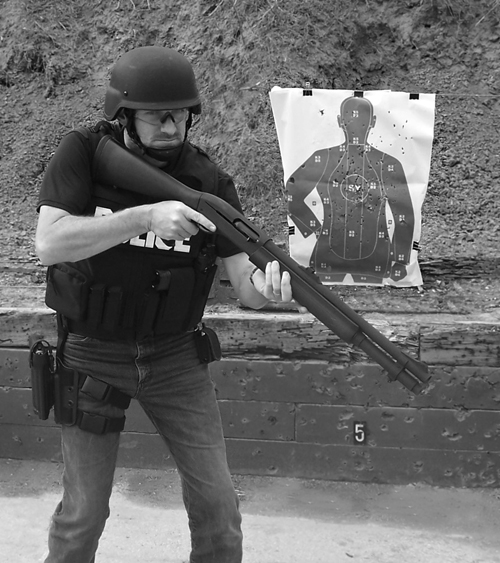This law-enforcement version of the Model 11-87 shotgun is all business. The Model 11-87 Police series guns feature synthetic stocks and fore-ends, Parkerized metal finish, and a choice of bead (No. 9859), rifle sight (No. 9861, tested here) or a Wilson Combat ghost-ring rear sight and an XS front sight (No. 9849). There is also a 14-inch-barrel version (No. 9847) with rifle sights.

In our testing over the years, Remington’s gas-operated autoloading action has proved itself to be reliable and durable in hunting and competition situations. In this use, its low recoil means excellent control in high-rate-of-fire situations with heavy buckshot or rifled slug loads. For training and familiarization, this shotgun also handles lighter loads.
The receiver, barrel, magazine extension, and bracket are coated with a Parkerized metal finish that minimizes reflections and provides moisture and abrasion resistance.
The polypropylene stock and fore-end have a matte-black finish that won’t reflect light, and the stock has molded checkering and is finished with a 1.2-inch-thick black ribbed R3 recoil pad. Stock dimensions included a length of pull of 14 inches and a drop at heel of 2.25 inches from the top of the action. The gun didn’t have a comb. The drop at heel from the sightline was 3.0 inches, and the stock had a lot of pitch.
The gun had a maximum width of 2.1 inches across the receiver at the action handle, and the polypropylene pistol grip handle was 1.4 inches thick and 5.0 inches around at the top. The fore-end was 1.9 inches thick. This gun measured 38.7 inches in OAL with an 18-inch barrel. Its overall height was 7.1 inches, and unloaded it weighed 8.3 pounds. It carried six rounds in the tube.
The receiver was matte-black steel, just like the barrel. No choke tubes were provided, and the muzzle wasn’t threaded for tubes. It was choked Improved Cylinder to allow it to shoot slugs. Our gun’s buttstock included a fixed sling-swivel stud in the buttstock and swiveling stud on the barrel/magazine bracket.
There was a lot to like about the 11-87. In particular, it had a compact feel, topnotch fit and finish, and the recoil pad made it comfortable to shoot. Also, the crossbolt safety was easy to disengage, but still offered a positive “click” when it came on and off. The blaze-orange magazine follower permitted quick inspection of the chamber and magazine.

Our testers thought the pistol grip was too long, but the shelf at the bottom offered a comfortable place to rest the hand. The top of the grip also felt too square for our tastes, and we’d probably buy this gun with the ghost-ring sights given the choice.
But the Remington won this evaluation on the strength of its ease of operation, soft shooting action, and accuracy. As we noted above, loads pounded our shooters when they emptied the magazines, but the recoil was much worse on the HK/Fabarm and FN guns, in our view. One tester commented, “We’d shoot a full magazine from one of the others and get stung, then pick up the 11-87, shoot it and say, ‘How nice!'”
Reloads were easy, too. To test reload speeds, we’d load one in the chamber, fire it, then load another and fire it. Shot-to-shot times were much faster with the Remington. Our shooters would start with rounds tucked between the belt and the pants (civilian style), or in a shell holder in full police gear. Once the first round was fired, keeping the gun shouldered, the shooter could control the shotgun with the trigger hand on the pistol grip. Then, he could tilt it slightly counterclockwise to expose the now-open ejection port, drop a shell into the receiver, hit the big carriage-release lever on the bottom of the follower with the left hand to close the action, then in the same motion, continue sliding the left hand onto the fore-end. That took about 3 seconds. If getting the next shot off wasn’t crucial, the shooter could just as easily feed more shells into the bottom of the gun until another threat appeared.
We had no hiccups shooting any of the shotshells, and the accuracy with the Remington slugs was great. Point of impact was 2 inches above the aiming point at 15 yards, and the groups were about 2.2 inches across (the slugs tear ragged holes). But we had the confidence to shoot at pieces of the silhouette target (ear, shoulder, crotch) and get hits with the slugs. One of our testers called this “surgical” performance, which is notable in a shotgun.


























